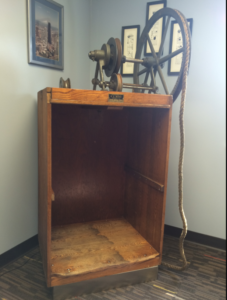How do dumbwaiters work?
April 2, 2020What is a Dumbwaiter?
Dumbwaiters are small freight elevators that move goods and materials. Also known as lifts in some parts of the country and world, dumbwaiters are used within many industries – including residential, food services, and healthcare.
A dumbwaiter is a movable frame in a shaft, powered by a motor that guides that shaft on a set of rails. Think of it as a “micro-elevator” that is designed to move things, rather than people.
What is a Dumbwaiter Used For?
What makes dumbwaiters so critical to business operations is the efficiencies they bring. A Dumbwaiter is a Lift System for hoisting material vertically within a building and has code-regulated width, depth and height size, and lifting capacity. Dumbwaiters can be designed to serve in a variety of challenging instances and unique scenarios (read through our dumbwaiter and lift case studies for examples) including in restaurants where space is limited or at hospitals when moving supplies quickly between floors is critical.
Regardless of how they are used, however, the basic form and function (the principles and components of dumbwaiter operation) of these systems have not changed in over 100 years.
How Do Dumbwaiters Work?
DID YOU KNOW? The first dumbwaiter brake system was patented by New York City inventor George W. Cannon in 1883. Cannon later filed for the patent on the mechanical dumbwaiter in 1887.

Matot Dumbwaiter from the 1940’s
In the distant past, dumbwaiter frames were often made of wood (see the image of a Matot dumbwaiter from the 1940’s) and required rope and pulley systems to move. Today’s dumbwaiters, such as those designed and manufactured by Matot, are built with the highest quality steel and powered by highly-engineered electrical motors that make it possible to move hundreds of pounds of materials and do so safely and reliably.
Dumbwaiters of the 21st Century & Beyond
So, how do dumbwaiters work today? Today’s dumbwaiters have numerous electrical components that enable users to control movement, temperature, humidity, and a range of other environmental factors that may influence the integrity of the goods or materials being delivered.
Dumbwaiters and lifts are very common in commercial and industrial settings, active parts of many buildings and facilities. As a result, there are many building regulations and codes that dumbwaiters must be in compliance with including those that require these systems to be fireproof.
Matot dumbwaiters and lifts, for example, can be designed and manufactured with fireproof walls and self-closing gates. When moving precious cargo and important or sensitive material, that’s an important feature to possess in a dumbwaiter but today’s lift systems can go even further to protect goods being moved. There are many instances where Matot has worked on dumbwaiter and lift systems for moving hazardous materials.
How Will Your Dumbwaiter Work?
There are many considerations to make when it comes to designing and manufacturing a dumbwaiter for specific use in a commercial building or industrial facility. Working with a trusted, experienced manufacturer like Matot will give you the confidence in knowing that these critical systems will work as intended when needed.
Get in touch with a Matot representative to discuss how to make our dumbwaiters and lifts integrate seamlessly with your project.
Back To Blog
Download Masterspecs
Matot’s master specifications are for use for all products.
Browse MasterspecificationsDesign & Planning Services
Our Planning Center has everything from basic information to final drawings.
Get Started With Matot